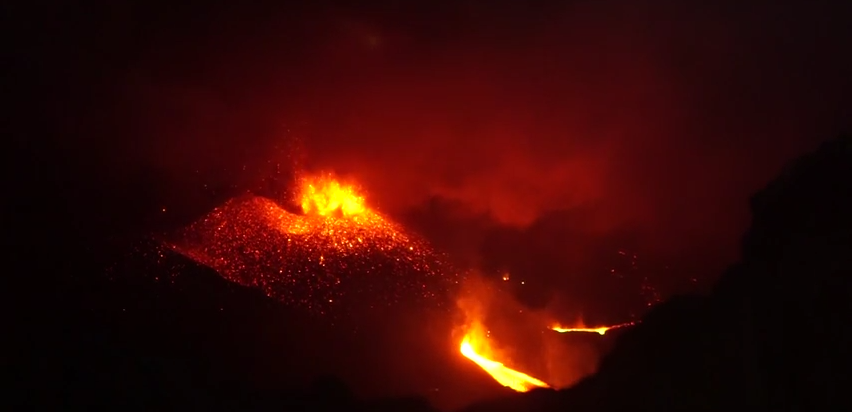Volcanic ash blankets the skies over Indonesian archipelago: Simultaneous eruption of 5 volcanoes

Five volcanoes of the Indonesian archipelago simultaneously erupted on Wednesday, July 22, 2015. The spewing ashes clouded the skies over the islands, suspending the flights on three airports in the area. Since last month, 13 000 people have been evacuated due to volcanic eruptions in Indonesia, mainly across the slopes of Sinabung in Tanah Karo District.
Ashes erupting simultaneously from Gamalama, Dukono, Sinabung, Raung and Karangetang, represent a natural phenomenon, and are not considered unusual among the nation surrounded by about 130 active volcanoes, said Dr. Surono, Indonesian geophysicist and volcanologist. "Our evaluation showed there is no extraordinary natural phenomenon that triggered simultaneous eruptions of the five volcanoes."
Transport Ministry spokesman Julius Adravida Barata said Jember and Banyuwangi airports closed Tuesday, July 21 and Bali's international airport was closed for several hours on Wednesday, July 22. 37 flights to and from Bali's Ngurah Rai airport were canceled, as well.
#Sinabung @beidarSinabung #FirdausS July 21- 10.27 am The sequal of #Eruption today @infobencana @chematierra pic.twitter.com/9vRY9xLD5r
— Leopold Kennedy Adam (@LeopoldAdam) July 21, 2015
The Indonesian National Board for Disaster Management (BNPD) reported the highest, level 4, activity for Sinabung volcano, on Sumatra island, during July 18 and 19. High seismicity and constant extrusion of the lava dome was measured, as the ash plumes rose as far as 1 km of altitude (around 3 280 feet). During July 18 to 20, explosions generated ash plumes rising up to 3.7 km (12 000 feet) and drifting eastward. On July 21, white plumes from the volcano rose 200 m (around 656 feet) in altitude.
(#MOUNT #ERUPTION #RAUNG) Airport Closed, Vice President Stuck in Bali- http://t.co/21Pmee0LQE
— Alberto Allen (@albertoallen) July 22, 2015
Information issued from the Centre for Volcanology and Disaster Hazard Mitigation (PVMB) in combination with satellite images and pilot observations say the multiple ash plumes from Raung volcano on Java island rose to altitudes between 3.7 and 6.1 km (12 000 to 20 000 feet), in the period of July 15 to 21. Roaring and thumping sounds and constant tremor were reported by the locals, while incandescent lava the volcano summit was visible, as well. Due to its activity the Juanda International Airport in Surabaya closed and re-opened again on several occasions during previous week. The alert level remained 3, and people were warned not to approach the area within a radius of 3 km (1.8 km).
Raung is one of Java's most active volcanoes, situated at a height of 3.3 km (2 miles) and truncated by a steep-walled caldera, 2 km wide (1.2 miles). Its eruptions were frequently recorded in history. A prehistoric eruption has caused a large debris avalanche that traveled 79 km (49 miles), almost reaching all the way to the Indian Ocean.
Indonesia Gamalama erupts with ash plume 1.5 km into the sky photo by piter silulu #gamalama #volcano #eruption pic.twitter.com/6KWhtMT5T4
— Aris Yanto (@aris_volcano) July 16, 2015
Explosion at Gamalama volcano on July 16, generated a white-gray plume, rising up to 1.5 km (4 921 feet) above the summit and drifting northwards. The volcano was constantly active during July 18 to 19, as well, generating a plume which rose to a height varying between 300 to 800 m (984 to 2 624 feet) and drifting northwest, BNPD reports.
The Sultan Babullah International Airport in Ternate was closed on the occasion, 1 505 people were displaced by the eruption and ash deposits across the affected villages were 1.5 to 6 mm (0.06 to 0.23 inches) thick. In the period between July 16 and 20, ash plumes rose to altitudes of 2.1 to 5.5 km (7 000 and 18 000 feet), and drifted 20 to 130 km (12.3 to 80.7 miles) northeast, northwest, west and southwest, according to Darwin Volcanic Ash Advisory (VAAC).
Gamalama eruptions were frequently recorded since the 16th century.

Video credit: Aris Yanto
In the period between July 16 and 19, the ash plumes from Dukono volcano, in northern Halmahera, rose up to the altitudes of 1.8 to 2.4 km (between 6 000 and 8 000 feet) and drifted 20 to 120 km (12.3 miles to 74.5 miles) north, northwest, west and southwest, Darwin VAAC reported.
Dukono volcano is a remote volcano, which rarely erupts nowadays, however, it used to be one of the Indonesia's most active volcanoes, in the period between 1933 and mid 1990s. It is most known by its eruption in 1550 when the lava flow filled in the strait between Halmahera and north-flank cone of Gunung Mamuya.
Featured image: Mount Raung eruption made volcano cone and fresh lava river, July 7, 2015. Image credit: Aris Yanto

Earth healing by itself